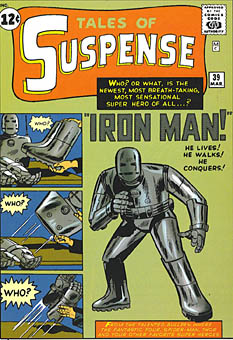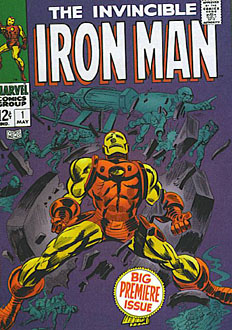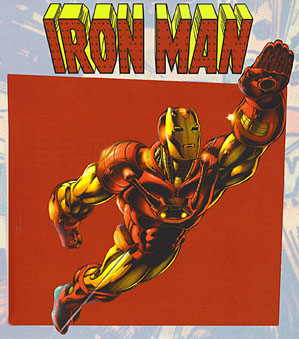Comic Book Confidential: Iron Man Primer
 While my knowledge of comic books is fairly extensive, Marvel has always been a weak spot for me. In the 1970’s, I was exposed to the classics through treasury edition books that featured reprints of the classic stories from the 1950’s and 1960’s but that was just about the limit of my formal education on the works of this prolific publisher. With the release of the new Iron Man film this past weekend, I felt the need to reintroduce myself to this comic book icon and share the results of my research with new fans or others in need of a refresher course.
While my knowledge of comic books is fairly extensive, Marvel has always been a weak spot for me. In the 1970’s, I was exposed to the classics through treasury edition books that featured reprints of the classic stories from the 1950’s and 1960’s but that was just about the limit of my formal education on the works of this prolific publisher. With the release of the new Iron Man film this past weekend, I felt the need to reintroduce myself to this comic book icon and share the results of my research with new fans or others in need of a refresher course.
One note of historical interest before we get into the dissertation proper, Marvel’s Iron Man was not the first Iron Man.In 1940, Quality Comic’s Smash title presented a story about a private investigator named Hugh Hazzard who thwarts an evil scientist’s scheme to commit robberies using an advanced robot he has created. At the conclusion of the story, Hazzard keeps the robot and dubs him Bozo, the Iron Man. While Bozo was technically a robot and not a suit of armor like the latter Iron Man, Hugh Hazzard would often ride inside the mechanical man and use him in a similar fashion. It’s certainly not hard to believe that this concept could have inspired Stan Lee and Jack Kirby a few years later. Bozo’s adventures ran for 42 issues in Smash Comics until Quality was purchased by DC in 1956. There has never been a proper Silver Age appearance of either Hazzard or Bozo but anything is possible in comic books.
In the early 1960’s, superhero titles were not very popular with comic book readers. Westerns, war stories, and even funny animal books seemed to garner more sales than what is now considered the primary genre of the media. Supernatural and monster related anthologies also sold well and there was a wide variety of titles to choose from at the local drugstore or newsstand. In March of 1963, the thirty-ninth issue of one of these anthologies, Tales of Suspense, featured an interesting character on the cover who looked like a hostile pipe welder in a clunky metal suit and called himself Iron Man.
 Before there was Iron Man though there was Tony Stark, a wealthy weapons designer with a lucrative contract supplying the United States military with the latest technology. During a research mission in the jungles of Vietnam, Stark became the victim of an enemy booby trap and suffers what should have been fatal wounds as the result of the explosion. Fortunately he was recognized by the warlord behind the attack who planned to use Stark to manufacture weapons for his army. To keep Stark alive, the warlord has his chief scientist construct a magnetic chest plate that prevents the shrapnel in his body from reaching his heart. Rather than build weapons though, Stark used the materials at his disposal to create a flying suit of armor and escape from the warlord’s prison.
Before there was Iron Man though there was Tony Stark, a wealthy weapons designer with a lucrative contract supplying the United States military with the latest technology. During a research mission in the jungles of Vietnam, Stark became the victim of an enemy booby trap and suffers what should have been fatal wounds as the result of the explosion. Fortunately he was recognized by the warlord behind the attack who planned to use Stark to manufacture weapons for his army. To keep Stark alive, the warlord has his chief scientist construct a magnetic chest plate that prevents the shrapnel in his body from reaching his heart. Rather than build weapons though, Stark used the materials at his disposal to create a flying suit of armor and escape from the warlord’s prison.
Iron Man’s initial appearance proved so popular that he was immediately brought back for the next issue and continued to dominate Tales of Suspense for the next sixty issues. Finally, in 1968, Iron Man graduated to his own title with The Invincible Iron Man number one, following a brief team up series with the Sub-Mariner. By this point, Starke’s armor had already been upgraded several times and more closely resembled the design still associated with it today. Many new villains, like Titanium Man, the Crimson Dynamo, and his chief nemesis The Mandarin were introduced to keep the stories fresh and the comic books selling.
Shortly after he began his crime fighting career, late 1963 to be exact, Iron Man would make a monumental contribution to the Marvel Universe when he formed The Avengers. Two years earlier, DC had combined seven of their most popular superheroes into a team they dubbed the Justice League of America and comic books bearing that title had been flying off the shelves ever since. Hoping to cash in on the super group phenomenon, Marvel used the popular and financially effluent character of Iron Man to gather together Thor, Hulk, Ant Man, and The Wasp into their own top tier team. Even though the roster changed almost from issue to issue, The Avengers were a hit and even lead to the revival of Captain America a short time later.
 In 1966, Iron Man joined Captain America, Thor, the Sub-Mariner, and the Hulk as part of the cryptically titled Marvel Superheroes Cartoon Show. Each half hour program featured an approximately five minute chapter in a story featuring each of the five main characters. The animation for these cartoons was extremely limited and most action sequences were portrayed with nothing more than a static comic book panel and sound effects! While the show only lasted for 65 episodes, it helped to introduce young audiences to many of the characters they saw regularly in the comic racks and the conveniently brief episodes were used in all types of permutations in syndication for years to come.
In 1966, Iron Man joined Captain America, Thor, the Sub-Mariner, and the Hulk as part of the cryptically titled Marvel Superheroes Cartoon Show. Each half hour program featured an approximately five minute chapter in a story featuring each of the five main characters. The animation for these cartoons was extremely limited and most action sequences were portrayed with nothing more than a static comic book panel and sound effects! While the show only lasted for 65 episodes, it helped to introduce young audiences to many of the characters they saw regularly in the comic racks and the conveniently brief episodes were used in all types of permutations in syndication for years to come.
Iron Man was overlooked in the 1970’s when all manner of Marvel superheroes were licensed for a group of, mainly uninspired, television pilots that resulted in series for Spider-Man and the Hulk. We did get the thinly-disguised 1977 TV movie Exo-Man starring David Ackroyd but the less said about that the better. Now in 2008 we have the first big screen adaptation of this nearly fifty year old Marvel cornerstone. Robert Downey, Jr. seemed an unlikely choice for the role of Tony Stark but has won audiences over as a child protégée turned playboy turned superhero. The plotline sticks fairly closely to the comics, an equation that almost always leads to success in my book (why fix what isn’t broke?), with the minimal updating not affecting the story. Several events throughout the history of Iron Man are woven together into a satisfying tapestry and the film is littered with references to possible future films to come.
Robert Downey, Jr. has already signed a three-picture deal so at least two more Iron Man movies are likely in the future. He is also slated to make a cameo in the next Hulk film, possibly furthering the setup for a film featuring The Avengers. If Marvel can continue to meet the high standards set by the first Iron Man film, they should find themselves with a lucrative franchise that continues to please comic book fans for years to come.
